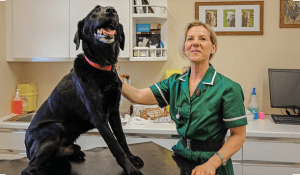Epilepsy In Dogs.
Epilepsy is a relatively common neurological disorder in dogs. It is characterized by frequent seizures, as a result of an abnormality in the brain. This can be quite distressing for dog owners, although usually, dogs deal fairly well with the condition once treatment has been sought. In this article, Holidays4Dogs finds out more about this condition, including symptoms and treatments for canine epilepsy.
Epilepsy is a brain disorder that can cause sudden onset fits in dogs and it is one of the most common neurological problems in dogs, (and also cats). While it can be brought on by trauma to the head, tumour in the brain, liver or kidney disease, it can also be an inherited disease, (genetic epilepsy).
When a dog has an epileptic seizure, bodily spasms occur which can last from 1 -3 minutes. The dog may foam at the mouth and possibly lose bladder and bowel control. The dog will be unconscious while this is happening and, therefore, unaware and un-responsive. Once the seizure is over the dog may be dazed and unsteady, although some dogs recover quickly and behave normally straight away.
Diagnosis.
Diagnosing epilepsy in dogs can be difficult because there can be many different causes.  It is therefore helpful for owners to provide as much information as possible about the nature of the seizures. Rarely, some dogs may only have one episode in their lives.
It is therefore helpful for owners to provide as much information as possible about the nature of the seizures. Rarely, some dogs may only have one episode in their lives.
Dogs that have had more than one seizure, are likely to have recurring episodes. It is important to inform your vet so treatment can be started as soon as possible.
Treatment.
Unfortunately, epilepsy is incurable, even with treatment. Some dogs will continue to suffer with periodic seizures throughout their lives.
However, it is perfectly possible for dogs to maintain a good quality of life, with carefully managed medication.
Medical management of epilepsy in dogs is improving all the time. There are many different drugs available to treat epilepsy. There may be a period of adjustment in order to get the correct type and dose of medication. This, ‘tweaking’, of medication can sometimes take several weeks.
Experts recommend keeping a diary of your dog’s seizures. This should include the time of day, duration and possible pre-cursors to the fit. A video of each seizure will similarly help your vet to establish whether treatment goals are working.
What to do if your dog has a seizure.
If your dog has a seizure, there are a few things you can do to help protect your pet.
-
Remove objects or other hazards from around the area where your dog is lying.
-
Where possible, reduce sounds and lights from the environment – switch off bright lights, television, music etc.
-
Don’t hold your dog while he is fitting and avoid putting your fingers near his mouth as he may be apt to bite while in this state. (Once he has come round, it is then safe to provide him with comfort if he needs it).
If your dog has been fitting for more than 2-3 minutes you should call your vet immediately. Likewise, if your dog has experienced more than 2 seizures in 24 hours, make arrangements to get your dog to the vet as a matter of urgency.
Conclusion.
While it does depend somewhat on the amount of seizures a dog experiences, the prognosis for dogs with epilepsy is largely good. With the correct medication and management, there is no reason why dogs cannot go on to live long and happy lives.
At Holidays4Dogs we have lots of carers experienced in looking after dogs with epilepsy, (as well as other manageable conditions such as diabetes).
If you seek complete peace of mind regarding your dog’s medical needs while you are on holiday – please do not hesitate to give us a call and we will match you with one of our experienced and trusted dog care experts.


